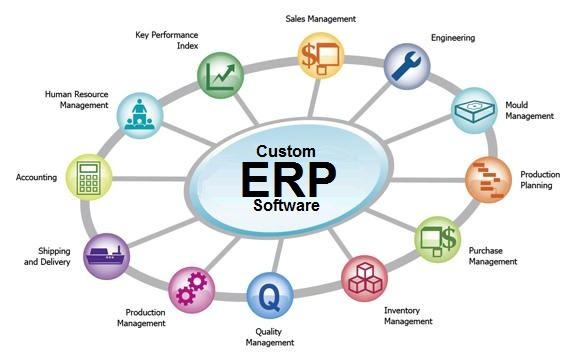This blog review Enterprise Resource Planning or ERP Implementation procedures and critical success factors. Now the ERP use is generally common in big corporations and even SME’s are using various available ERP packages. But not every company gets the return from using the ERP system. I have been part of 3 different ERP systems and in my experience companies are failing to set up the ERP system because they cannot reach the predetermined goal. The ERP is not only a technology that supports management but also a way of management. ERP provides many benefits but in nutshell, any ERP system provides two major benefits that do not exist in non-integrated departmental systems:
- A unified enterprise view of the business that encompasses all functions and departments; and.
- An enterprise database where all business transactions are entered, recorded, processed, monitored,

My experience suggests 9 critical factors for the successful ERP implementation:
- A clear understanding of strategic goals
- Commitment by top management
- Excellent project management
- Organizational change management
- A great implementation team
- Data accuracy
- Extensive education and training
- Focused performance measures (See Supply Chain KPI Dashboard)
- Multi-site issues
So from these critical factors, we can find that a successful implementation of the ERP system is not only set up technology support of the information system but also change the way of management. Successful ERP implementation requires the organization to engage in excellent project management. This includes a clear definition of objectives, the development of both a work plan and a resource plan, and careful tracking of project progress. And the project plan should establish aggressive, but achievable, schedules that instill and maintain a sense of urgency. A clear definition of project objectives and a clear plan will help the organization avoid the all-too-common ‘‘scope creep’’ which can strain. From this part, we can find that the ERP system is an information system. It is in charge of the collection, storage, and supply of information. But the critical factor of success is not how to build the information system but how to use the information that we get from the information system.
Unfortunately, some companies view ERP implementation as simply a software system and the implementation of ERP as primarily a technological challenge. They do not understand that ERP implementation may fundamentally change the way in which the organization operates. This is one of the problematic issues facing current ERP systems. I think the reason why ERP implementation fails is generally due to poor planning or poor project management, change in business goals during the project, and lack of business management support are the top three reasons for the failure of IT-related projects cited by IT managers. I believe that the main reason why implement fail is not the failure of the ERP system itself but the usage of the ERP system.
How to Choose an ERP system?
How to choose an ERP system that is adapted to the company is very difficult and there are no fix standard criteria available to decide. The key steps to choose the ERP system from available choices:
- Create the vision.
- Create a feature/function list.
- Create a software candidate list.
- Narrow the field to four to six serious candidates.
- Create the request for proposal (RFP).
- Review the proposals.
- Select two or three finalists.
- Have the finalists demonstrate their packages.
- Select the winner.
- Justify the investment.
- Negotiate the contract.
- Run a pre-implementation pilot.
- Validate the justification.
11 Recommended Steps for a Successful Implementation
ERP systems can be complex and difficult to implement, but a structured and disciplined approach can greatly facilitate the implementation. Here are 11 recommended steps for a successful ERP implementation:
- Review the pre-implementation process to date.
- Install and test any new hardware.
- Install the software and perform the computer room pilot.
- Attend system training.
- Train on the conference room pilot.
- Establish security and necessary permissions.
- Ensure that all data bridges are sufficiently robust and the data are sufficiently accurate.
- Document policies and procedures.
- Bring the entire organization online, either in a total cutover or in a phased approach.
- Celebrate.
- Improve continually.
The ERP system is a complex system, and it is a hard job to implement the ERP system successfully. The second question is why. Why do we need the ERP system. What can be brought by the ERP system?
The ERP system including finance management, Supply Chain management and human resource management. So the implementation of the ERP system should be the change of the whole company management. It is better to hire a professional consulting company to do the case. They can help you to analyze your business, and they are familiar with the different ERP systems. So by reading this article, we can find the key factor of the successful implementation of the ERP system. That is looking the ERP system as the innovation of the company management. Not only look the ERP system as software can make any decision.
Want to learn more about Easy to use cloud accounting and finance tools for the education industry, click here.
Other Useful Reads:
The Top 10 ERP Books of All Times to Perfect Implementation
7 Crazy Reasons Why the Current ERP System Sucks (Mostly!)
9 Drowning ERP Implementation Risk Factors You Need to be Mindful of
Proven Benefits of ERP systems for effective Supply Chain Management
About the Author- Dr Muddassir Ahmed
Dr MuddassirAhmed is the Founder & CEO of SCMDOJO. He is a global speaker, vlogger and supply chain industry expert with 17 years of experience in the Manufacturing Industry in the UK, Europe, the Middle East and South East Asia in various Supply Chain leadership roles. Dr. Muddassir has received a PhD in Management Science from Lancaster University Management School. Muddassir is a Six Sigma black belt and founded the leading supply chain platform SCMDOJO to enable supply chain professionals and teams to thrive by providing best-in-class knowledge content, tools and access to experts.
You can follow him on LinkedIn, Facebook, Twitter or Instagram


